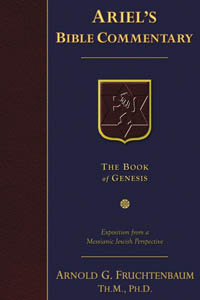
Author, Arnold G. Fruchtenbaum Th.M, Ph.D. Hardback, 478 pages, Published by Ariel Ministries, P.O. Box 792507, San Antonio, TX 78279-2507 ISBN 978-0-914863-11-8
It is extremely difficult for a twenty-first-century Gentile to identify with a first-century Jew when considering the impact of the New Testament teaching on their way of life, culture and religious heritage. The initial response on the part of some is seen in the reaction of Saul of Tarsus, while others, like Joseph of Arimathea and Nicodemus, grasped the reality and relevance of the Lord’s life, death and subsequent resurrection.
Following Pentecost, the first believers, who were almost entirely from the Jewish and proselyte communities, faced two main challenges to their new-found faith. The first was physical opposition, including theft of and damage to their property, resulting in a movement from Jerusalem and the Judean locality. Also, as a result of their ill-treatment, some were tempted to return to the fold of Judaism to find some relief. The second threat was the infiltration of false teachers seeking to undermine the faith of the Christians.
Dr. Fruchtenbaum explains that the first of these predicaments prompted the Epistles to the Hebrews, James and 1 Peter. While a response to the second problem resulted in 2 Peter and Jude. Notwithstanding the writer’s undoubted academic achievements, the style of this book is very readable and the textual explanations easy to follow. His understanding of the Jewish mind and customs give a refreshing insight to the Hebrew Epistle, while, above all, he makes clear that the theme of the letter is ‘the superiority of the Son’ and this is focused upon throughout.
Of the Epistle by James, he writes, ‘The letter is thoroughly imbued with the spirit and imagery of the Old Testament and Judaism’. References to the law and to the synagogue and reference to the Old Testament characters of Abraham, Rahab, Job and Elijah would maintain the interest of his readers. The teaching is, however, brought very clearly into the context of New Testament principles and practice.
In Peter’s first Epistle, the emphasis is upon his appeal to his readers as an elder and as a shepherd. Sympathizing with them in their suffering, but reminding them in each chapter of the sufferings of Christ, through which they have been brought into a unique place of blessing; exhorting them to cast all their care upon the One who cares for them.
The similarities between 2 Peter and Jude are noted, while the point is made that Peter wrote in the future tense in anticipation of false teachers, while Jude wrote in the past tense as seeing the fraudulent incomers already in place.
A handy index on the outer pages of the book enables the reader to refer quickly to any book, chapter and verse. This reviewer will now be looking for other writings by this author!
| Cookie | Duration | Description |
|---|---|---|
| cookielawinfo-checkbox-advertisement | 1 year | Set by the GDPR Cookie Consent plugin, this cookie is used to record the user consent for the cookies in the "Advertisement" category . |
| cookielawinfo-checkbox-analytics | 11 months | This cookie is set by GDPR Cookie Consent plugin. The cookie is used to store the user consent for the cookies in the category "Analytics". |
| cookielawinfo-checkbox-functional | 11 months | The cookie is set by GDPR cookie consent to record the user consent for the cookies in the category "Functional". |
| cookielawinfo-checkbox-necessary | 11 months | This cookie is set by GDPR Cookie Consent plugin. The cookies is used to store the user consent for the cookies in the category "Necessary". |
| cookielawinfo-checkbox-others | 11 months | This cookie is set by GDPR Cookie Consent plugin. The cookie is used to store the user consent for the cookies in the category "Other. |
| cookielawinfo-checkbox-performance | 11 months | This cookie is set by GDPR Cookie Consent plugin. The cookie is used to store the user consent for the cookies in the category "Performance". |
| elementor | never | This cookie is used by the website's WordPress theme. It allows the website owner to implement or change the website's content in real-time. |
| viewed_cookie_policy | 11 months | The cookie is set by the GDPR Cookie Consent plugin and is used to store whether or not user has consented to the use of cookies. It does not store any personal data. |